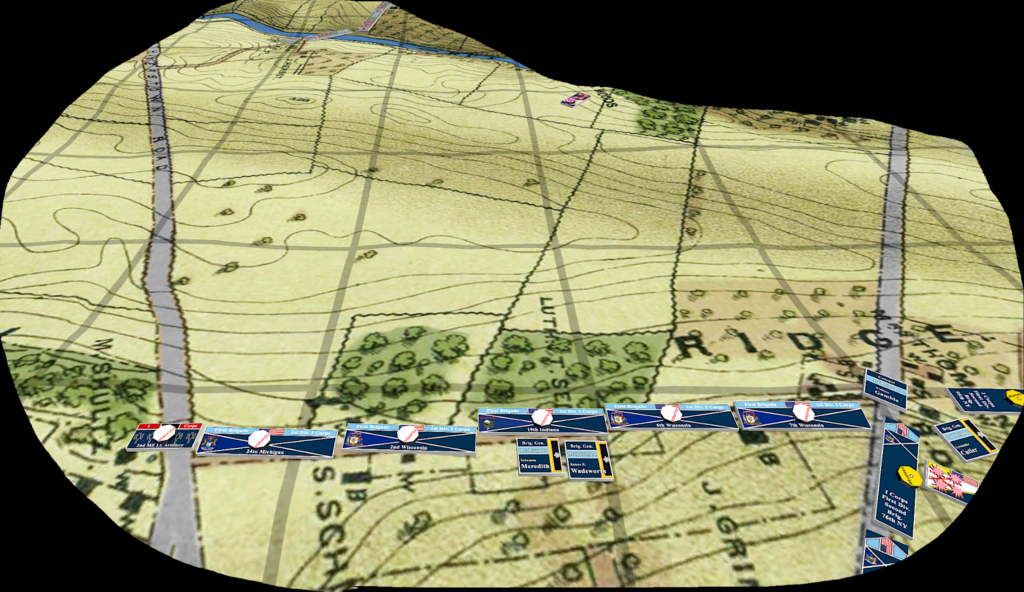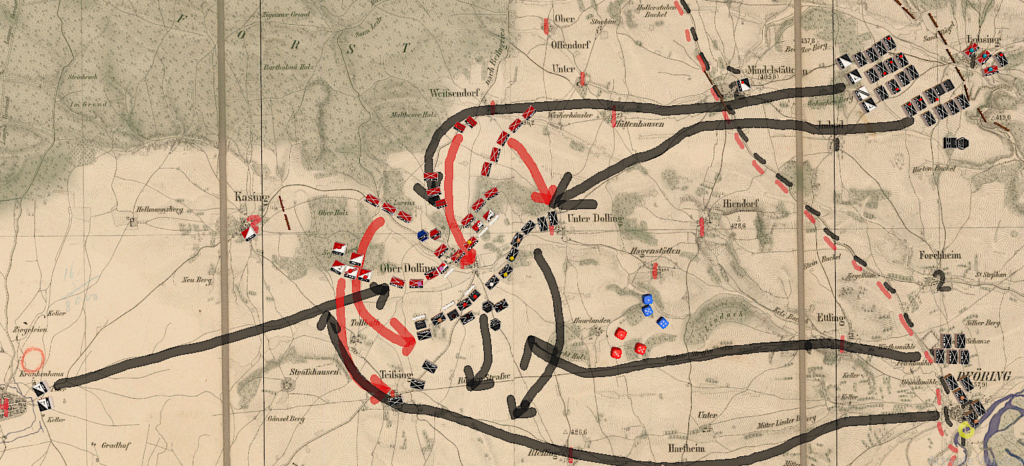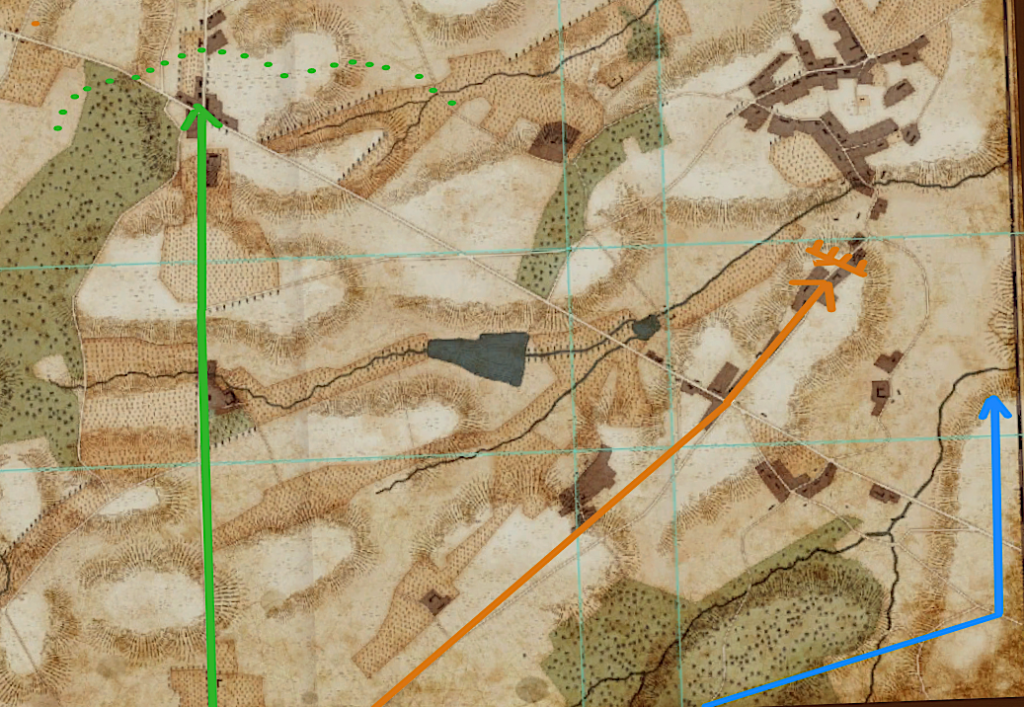James Horton is a Master Umpire at the IKS. In this post he describes his journey to Kriegsspiel and what he thinks are the core elements of a good game.
How I found Kriegsspiel
I grew up participating in roleplaying games since the age of 12. I started with Star Wars d6, then played various editions of D&D, and discovered Savage Worlds. A few years back, I was the gamemaster for a campaign set during the American Revolution. I wanted the players to participate in some important battles of the war. Savage Worlds has quick and simple rules to handle large battles, very simple. Running the large battles awakened a desire within me to better simulate those battles.
I began modifying and adding complexity to the Savage Worlds rules. We playtested new rules and re-enacted battles like Waterloo and Antietam. While fun, there was still something missing. Players on both sides had a God’s Eye view of the map. They had perfect knowledge of their army and the enemy army positions.
As I researched more about history and historical battles, I learned that this was far from reality. The intense fog of war was a major element impacting battles. So we modified the rules again where each player only saw their section of the map. Each side gave orders which were carried out simultaneously. An umpire adjudicated their orders based on a set of rules. Up to this point, I still hadn’t even heard the word Kriegsspiel (KS) but we were getting close to it naturally as we tried to make our games more and more realistic.

An example of one of my early games, a reenactment of the battle of Gettysburg.
As I did more research on wargaming rules, I came across youtube videos discussing Kriegsspiel. These led to a website for an International Kriegsspiel Society (IKS) and some interesting youtube videos showing a giant game reenacting the battle of Gettysburg. It looked fun so I contacted Marshall and invited him to join our game using my own rule system. I was curious to hear what he thought of it. After that, Marshall invited us to join the IKS discord which we did and soon found a fun community of hundreds of players who were playing dozens of games.

An example of one of my early games, a reenactment of the battle of Gettysburg.
My experience as a player
As a player in IKS, I joined multiple play-by-post (PBP) games which typically only take me 5-10 minutes a day to play on average. I also occasionally joined the Saturday live games which typically last 3-8 hours.
What I liked about the IKS games is that there’s generally a chain of command. The lowest level players often command a group of 6-10 unit pieces (typically infantry, artillery, or cavalry depending on the setting). But then there’s a commander in charge of multiple of these front-line commanders and then an overall commander in charge of everyone.
Having a chain of command really lets you simulate what it’s like to both give and receive orders. As an overall army commander, you have the fun job of being in command of everything and in control of nothing. You learn to sympathize with the Generals of old as you get outdated, inaccurate intel but must make quick, decisive decisions or risk losing the fight. You get to deal with commanders who misunderstand or outright disobey orders. It’s an absolute blast.
As a low level commander, often a division, brigade, or regimental level depending on the size and scope of the game, you feel what it’s like to serve as a small but important part of a large army. You learn what it feels like on the front lines when all you see is smoke in front of you and you don’t know if you outnumber your enemy or if it’s the other way around.

Screenshot of my command and what I could see as a Brigadier General in a recreation of Gettysburg Day 1 game.
Basically it lets you simulate as much as you can from a computer chair the feeling of acommander in battle with a strong fog of war element which limits your knowledge of what your enemy or even your allies are doing.
As a long-time lover of strategy-based board games and computer games, I find KS to be the ultimate strategy game.
My experience as an Umpire
I love playing games but I also always loved making games. Not too long after I joined IKS, I wanted to try my hand at umpiring. I started small with existing maps and pieces and small 2v2 then 3v3 games. Then I expanded, learned how to create and upload maps into Tabletop Simulator, the main tool we use to run games. I learned how to design and create pieces. I modified existing rule systems to fit what works best for me and I began running larger games with 20, 30, 40, and now 50 players at a time.
As an umpire, it’s fun for me to create problems and scenarios and then see how the players work to resolve them. I love learning the history as I create a new game. I love the fog of war and, with my God’s eye view, seeing players make mistakes based on incorrect assumptions or inaccurate information. It’s a lot of work, roughly 1-2 hours every other day at the pace I like to run my games. But it’s so much fun.

A screenshot of the fight during an American Revolution: New York Campaign game I ran within IKS.
How to make Kriegsspiel enjoyable
Kriegsspiel, at its most basic level, is a double-blind system with an umpire. Two sides each have their own map. The umpire has a master map where he tracks the positions of both sides and determines what happens in case of contact and fighting. Some additional elements which add realism include limiting the view-range to a specific commander only, order delays, and dispatch delays. This creates a realistic fog of war which simulates conditions on the battlefield experienced by the Generals of old.
I’ve already described previously why I enjoy the game. Now I’d like to share my views about how to design a scenario to be enjoyable to everyone.
These are the important elements:
Balance
Historical battles were never symmetrical nor balanced or fair. One side always had an advantage. I’m not saying KS battles should be either. But to be fun, the game should be balanced with a fair chance of winning for both sides. Now “winning” for one side may simply mean retreating with most of your army intact in a situation where you’re vastly outnumbered. Win conditions can vary. The important thing is players feel like they had a chance at meeting the winning conditions. Even if the forces aren’t balanced, it’s up to the umpire to determine balanced win conditions.

Screenshot showing a battle during a fictional Diplomacy-themed game.
Impact
Players want to leave their mark on the game. They want to make decisions that affect the outcome. I’ve been in games where the CiC (Top General) hands out orders, I follow those orders, and the game ends where I had no opportunity to make any decisions on my own. Games should be long enough such that most if not all players have the opportunity to make at least 2-3 impactful decisions on their own. Some games end where players don’t even participate in any fighting. This may be realistic but not as fun. I try to design my games in such a way that most players get into the action quickly and the game lasts long enough for everyone to be involved to some extent. I also frame the preparation and strategizing in such a way so that every player can make suggestions to the plan.

Map showing overall player actions and plans during a fictional Diplomacy-themed game.
Opportunity to shine
Every player wants to be the next Napoleon, Wellington, Rommel, Frederick the Great, Lee, or Grant. They want to make smart strategies that win games. The reason those Generals are famous was because they knew their opponents and could guess what they’d do and how they’d react. They had enough information to make decisions and enact cunning strategies. I find that most games don’t give that opportunity. Umpires don’t give enough information to the players or don’t allow enough time within the game for the information to be gleaned. Often your enemy is an unknown quantity, a player you’ve never played against before. The more an umpire can create scenarios where a player has enough information and time to enact smart strategies, the more fun it will be for everyone.

Map showing on team’s planning in a small Quatre-Bras game.
Kriegsspiel is a wonderful opportunity to experience historical battles, both actual and artificial, from the perspective of a commanding officer. The nature of Kriegsspiel creates a strong fog of war that, while sometimes frustrating, can be a lot of fun. It is the ultimate strategy game. If you haven’t played KS or joined the IKS community yet, I strongly encourage you to do so.
James Horton

Join our Discord server and become part of a growing community of over 750 members from all around the globe.
Get in touch either on Discord or via e-mail, leave us some feedback or suggestions or ask us anything about Kriegsspiel.
The IKS is commited to ensure inclusiveness and diversity within the community and stands against discrimination and harassment.






